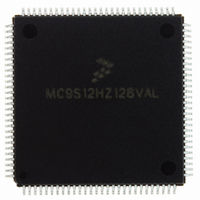MC9S12HZ128VAL Freescale Semiconductor, MC9S12HZ128VAL Datasheet - Page 110

MC9S12HZ128VAL
Manufacturer Part Number
MC9S12HZ128VAL
Description
IC MCU 16BIT 2K FLASH 112-LQFP
Manufacturer
Freescale Semiconductor
Series
HCS12r
Datasheet
1.MC9S12HZ128CAL.pdf
(692 pages)
Specifications of MC9S12HZ128VAL
Core Processor
HCS12
Core Size
16-Bit
Speed
25MHz
Connectivity
CAN, EBI/EMI, I²C, SCI, SPI
Peripherals
LCD, Motor control PWM, POR, PWM, WDT
Number Of I /o
85
Program Memory Size
128KB (128K x 8)
Program Memory Type
FLASH
Eeprom Size
2K x 8
Ram Size
6K x 8
Voltage - Supply (vcc/vdd)
2.35 V ~ 5.5 V
Data Converters
A/D 16x10b
Oscillator Type
Internal
Operating Temperature
-40°C ~ 105°C
Package / Case
112-LQFP
Processor Series
S12H
Core
HCS12
Data Bus Width
16 bit
Data Ram Size
6 KB
Interface Type
I2C/SCI/SPI
Maximum Clock Frequency
50 MHz
Number Of Programmable I/os
85
Number Of Timers
8
Maximum Operating Temperature
+ 105 C
Mounting Style
SMD/SMT
3rd Party Development Tools
EWHCS12
Minimum Operating Temperature
- 40 C
On-chip Adc
16-ch x 10-bit
Lead Free Status / RoHS Status
Lead free / RoHS Compliant
Available stocks
Company
Part Number
Manufacturer
Quantity
Price
Company:
Part Number:
MC9S12HZ128VAL
Manufacturer:
Freescale Semiconductor
Quantity:
10 000
Part Number:
MC9S12HZ128VAL
Manufacturer:
FREESCALE
Quantity:
20 000
- Current page: 110 of 692
- Download datasheet (4Mb)
Chapter 3 2 Kbyte EEPROM Module (EETS2KV1)
3.4.1.2
The EEPROM command controller is used to supervise the command write sequence to execute program,
erase, mass erase, sector modify, and erase verify operations. Before starting a command write sequence,
it is necessary to check that there is no pending access error or protection violation (the ACCERR and
PVIOL flags must be cleared in the ESTAT register).
After this initial step, the CBEIF flag must be tested to ensure that the address, data and command buffers
are empty. If so, the command sequence can be started. The following 3-step command write sequence
must be strictly adhered to and no intermediate access to the EEPROM array is permitted between the 3
steps. It is possible to read any EEPROM register during a command sequence. The command write
sequence is as follows:
The completion of the command is indicated by the CCIF flag setting. The CCIF flag only sets when all
active and pending commands have been completed.
The EEPROM command controller will flag errors in command write sequences by means of the
ACCERR (access error) and PVIOL (protection violation) flags in the ESTAT register. An erroneous
command write sequence will abort and set the appropriate flag. If set, the user must clear the ACCERR
or PVIOL flags before commencing another command write sequence. By writing a 0 to the CBEIF flag
the command sequence can be aborted after the word write to the EEPROM address space or after writing
a command to the ECMD register and before the command is launched. Writing a 0 to the CBEIF flag in
this way will set the ACCERR flag.
A summary of the launching of a program operation is shown in
writes the appropriate command to the ECMD register.
110
1. Write an aligned word to be to a valid EEPROM array address. The address and data will be stored
2. Write a valid command, listed in
3. Clear the CBEIF flag by writing a 1 to CBEIF to launch the command. When the CBEIF flag is
in internal buffers.
— For program and sector modify, all address and data bits are valid.
— For erase, the value of the data bytes are ignored.
— For mass erase and erase verify, the address can be anywhere in the available address space of
— For sector erase, the address bits[1:0] are ignored.
cleared, the CCIF flag is cleared by hardware indicating that the command was successfully
launched. The CBEIF flag will be set again indicating the address, data, and command buffers are
ready for a new command write sequence to begin.
the array.
Command Write Sequence
MC9S12HZ256 Data Sheet, Rev. 2.05
Table
3-10, to the ECMD register.
Figure
3-18. For other operations, the user
Freescale Semiconductor
Related parts for MC9S12HZ128VAL
Image
Part Number
Description
Manufacturer
Datasheet
Request
R
Part Number:
Description:
Manufacturer:
Freescale Semiconductor, Inc
Datasheet:
Part Number:
Description:
Manufacturer:
Freescale Semiconductor, Inc
Datasheet:
Part Number:
Description:
Manufacturer:
Freescale Semiconductor, Inc
Datasheet:
Part Number:
Description:
Manufacturer:
Freescale Semiconductor, Inc
Datasheet:
Part Number:
Description:
Manufacturer:
Freescale Semiconductor, Inc
Datasheet:
Part Number:
Description:
Manufacturer:
Freescale Semiconductor, Inc
Datasheet:
Part Number:
Description:
Manufacturer:
Freescale Semiconductor, Inc
Datasheet:
Part Number:
Description:
Manufacturer:
Freescale Semiconductor, Inc
Datasheet:
Part Number:
Description:
Manufacturer:
Freescale Semiconductor, Inc
Datasheet:
Part Number:
Description:
Manufacturer:
Freescale Semiconductor, Inc
Datasheet:
Part Number:
Description:
Manufacturer:
Freescale Semiconductor, Inc
Datasheet:
Part Number:
Description:
Manufacturer:
Freescale Semiconductor, Inc
Datasheet:
Part Number:
Description:
Manufacturer:
Freescale Semiconductor, Inc
Datasheet:
Part Number:
Description:
Manufacturer:
Freescale Semiconductor, Inc
Datasheet:
Part Number:
Description:
Manufacturer:
Freescale Semiconductor, Inc
Datasheet:











